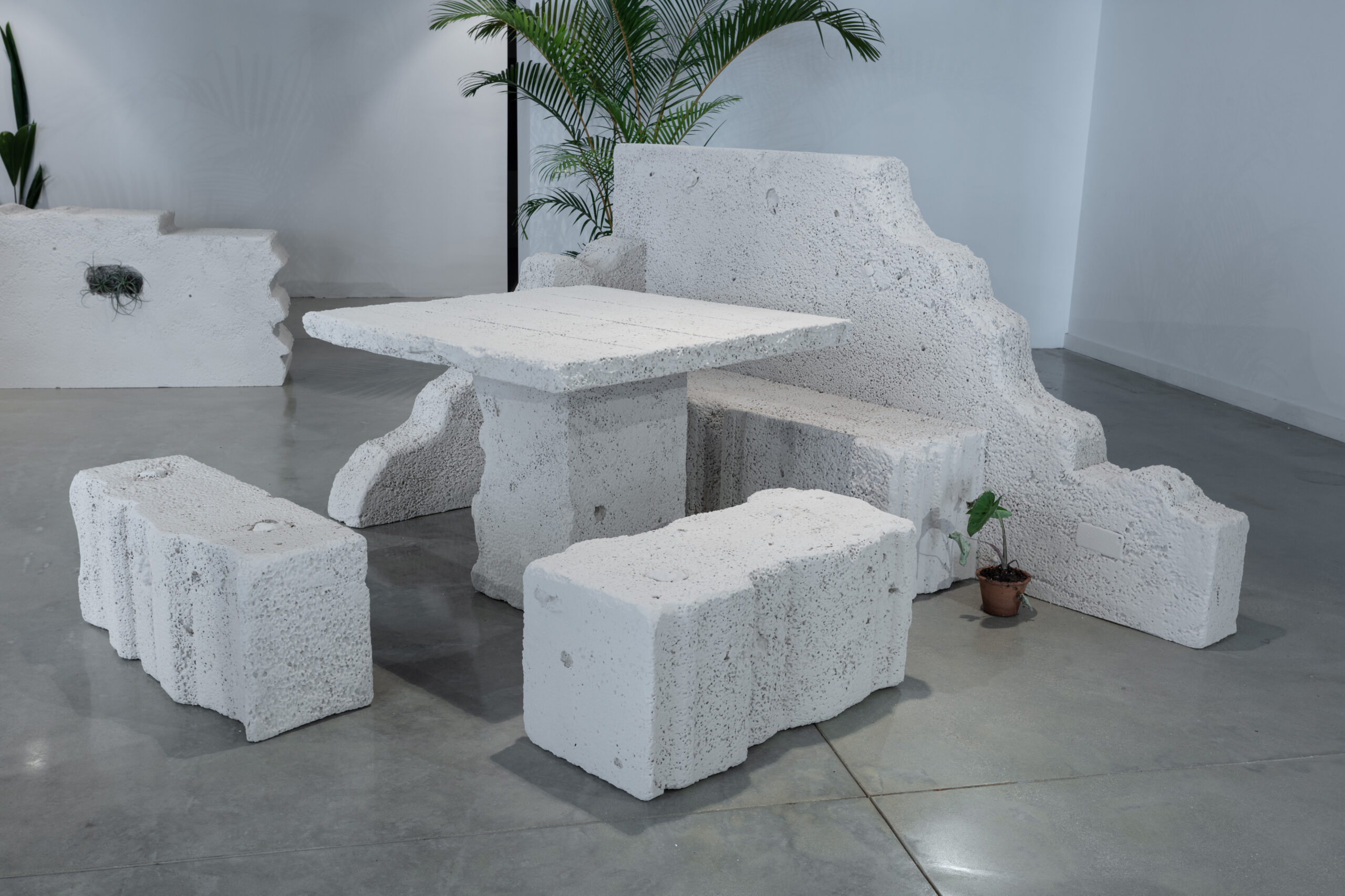Nina Johnson speaks to Emmett Moore in the eve of the opening of “The Grotto”

Gallerist Nina Johnson speaks to artist and designer Emmett Moore about his practice on the eve of the opening of The Grotto a site-responsive installation in the Miami Design District on view through April 28, 2021.
As a native Miamian, your work is often referred to as incorporating the “Miami Vernacular” but many of the materials you choose are seen throughout tropical and sub-tropical climates. Tell us about the material reference for The Grotto and how it relates to some of your recent material choices such as breeze block, used clothing, and mid-century Modernism.
One of the things I’m interested in is indigenous material, the kind of location-specific thing you can’t unsee once you notice it. When it comes to stone, Miami has coral rock. This happens everywhere – Mexico City has volcanic rock, for example. Miami isn’t the only city that uses coral and limestone as a building material and Mexico City isn’t the only city that uses volcanic rock but each material speaks to the cities’ histories. Breezeblocks and secondhand clothing are two materials that have a very specific narrative when it comes to Miami but have different stories elsewhere. With all of these material choices and references, I want to use objects in my periphery to connect to global conversations. Midcentury modern design is ubiquitous because it was a global movement to democratize quality design and therefore feels universal and timeless.
You actually went to high school in the Miami Design District at Design and Architecture Senior High. Tell us about that experience and how you feel it’s influenced the artist you’ve become today.
Believe it or not, the first year of Art Basel Miami Beach and Design Miami happened while I was still in high school. After (and during) school for several years, I helped exhibiting artists build their installations for “Basel Week”. The list of names is incredible. Being surrounded by professional artists and designers in the District the rest of the year taught me how I want to live my life and helped me develop my personal philosophy early on. At home I don’t draw much distinction between work and life nor do I see any major separation between architecture, furniture, and art. I want all of the objects and materials in my life to be meaningful.
Function is a critical aspect of your practice, while much of your work is intended to be used, you often think of function as a conceptual starting point. How do you see that playing out in The Grotto?
I see function as being, like most things, on the spectrum and some things exist just to be contemplated – that IS their function. Fast food restaurant furniture is designed to be comfortable as long as you’re eating but not for an extended hangout while movie theater furniture is meant to be comfortable for two hours or more but not so comfortable you immediately fall asleep. The Grotto is a functional artwork with a fluctuating balance between functional and conceptual. The seating in the installation is all essentially stools or benches but decidedly not chairs. Unless a chair exists entirely as a sculpture I believe there is somewhat of a level of ergonomics that should be adhered to. Straight-backed chairs are a copout!
The pieces in The Grotto are intended for both indoor and long-term outdoor use. Tell us about the current context and how you feel a more retail-oriented environment becomes an inspiration for this body of work?
My last studio was in an abandoned mall, and in my studio before that, I built an apartment where I lived for a couple of years. I like the subtle subversions of intended function and the way these dichotomies open up new corridors for thinking about our relationship to space and our built environment. This is very much the way I like to think about art and design, and the tensions that I exploit in my work. The space, the work is in now is a showroom that is being used as a gallery for furniture that is a sculpture.
Many say the current collectible design market was catapulted to its current status by the invention of Design Miami, which in fact, began in this very neighborhood, how do you feel your work has been inspired by the fair?
When I started designing objects I didn’t necessarily see them as products but more like self-aware investigations into the nature of design; like designing a lamp that questions what it means to be a lamp, which is a big part of what this whole “collectible design” thing (a terrible name) is all about. Design Miami is a platform for challenging design ideas and presenting alternative modes for thinking about the objects we live with. Having a dedicated place to see and exhibit this work is inspiring and enables its development. Plus, it gets a bunch of my friends to come to Miami every December and that is awesome!